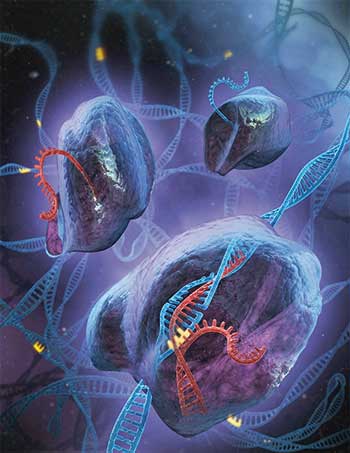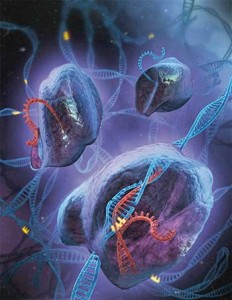CRISPRainbow Allows to Tag Seven Genomic Loci Simultaneously

 Researchers from University of Massachusetts Medical School have developed a new technique to simultaneously track up to seven genomic locations in live cells. The CRISPRainbow system is based on the genomic editing tool CRISPR/Cas9. The study was published in the journal Nature Biotechnology.
Researchers from University of Massachusetts Medical School have developed a new technique to simultaneously track up to seven genomic locations in live cells. The CRISPRainbow system is based on the genomic editing tool CRISPR/Cas9. The study was published in the journal Nature Biotechnology.
The three-dimensional structure of the genome has important consequences in gene expression. Genes can only be transcribed if they are accessible to the cellular machinery. Consequently, chromatin dynamics are paramount to understand phenomena like cell differentiation, embryo development and even cancer. Current techniques, however, allow to track only three genomic loci simultaneously in living cells. Treating the cells with formaldehyde allows to tag more genomic elements, but these fixed, dead cells offer static information: the spatio-temporal changes of the elements of interest are lost.
A guide RNA bound to a deactivated Cas9 and a fluorescent protein
The researchers from UMassMed conceived a creative solution based on the CRISPR technology. In the orthodox CRISPR/Cas9 tool, a single guide RNA (sgRNA) is engineered to target selected sequences. The endonuclease Cas9 binds the sgRNA and is transported to the selected genomic site, where it binds and cuts the DNA. In this study, however, Hanhui Ma’s team tweaked the genome editing tool in several ways. First, they deactivated the endonuclease activity of Cas9. Second, they engineered the sgRNA to make it capable of binding sets of fluorescent proteins. With these modifications, the sgRNA targets Cas9 to the desired site, but the nuclease-dead protein just binds to the DNA; additionally, the sgRNA carries a red, green or blue fluorescent protein, which can be tracked under a microscope in real time. Different combinations of these fluorescent proteins allow to combine their emitted primary colors, creating cyan, magenta and yellow labels. Combining the three primary fluorescent proteins, a white label is obtained.
CRISPRainbow allows to simultaneously tag seven genomic locations, track their movements and see how structural changes affect their expression. By observing cells with healthy and sick phenotypes, differences in spatio-temporal distribution of loci and their patterns of expression could be observed, allowing to understand a disease and find solutions. Chromosome dynamics in response to external stimuli can also be observed now in greater detail.
Source: UMassMed

